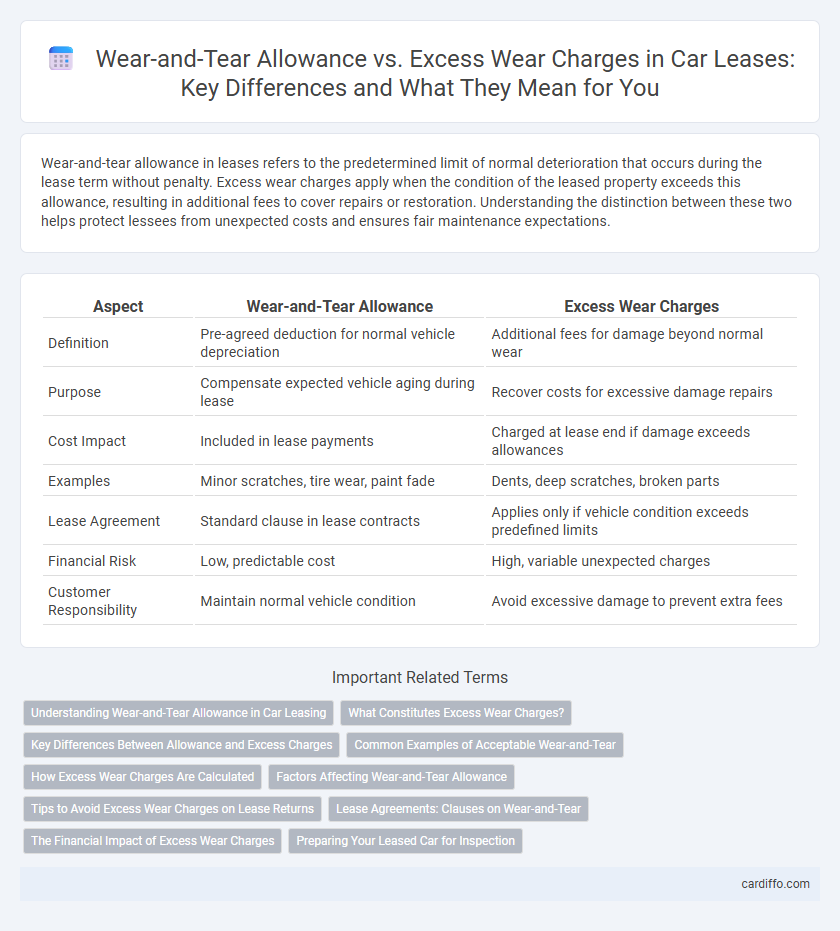Wear-and-tear allowance in leases refers to the predetermined limit of normal deterioration that occurs during the lease term without penalty. Excess wear charges apply when the condition of the leased property exceeds this allowance, resulting in additional fees to cover repairs or restoration. Understanding the distinction between these two helps protect lessees from unexpected costs and ensures fair maintenance expectations.
Table of Comparison
| Aspect | Wear-and-Tear Allowance | Excess Wear Charges |
|---|---|---|
| Definition | Pre-agreed deduction for normal vehicle depreciation | Additional fees for damage beyond normal wear |
| Purpose | Compensate expected vehicle aging during lease | Recover costs for excessive damage repairs |
| Cost Impact | Included in lease payments | Charged at lease end if damage exceeds allowances |
| Examples | Minor scratches, tire wear, paint fade | Dents, deep scratches, broken parts |
| Lease Agreement | Standard clause in lease contracts | Applies only if vehicle condition exceeds predefined limits |
| Financial Risk | Low, predictable cost | High, variable unexpected charges |
| Customer Responsibility | Maintain normal vehicle condition | Avoid excessive damage to prevent extra fees |
Understanding Wear-and-Tear Allowance in Car Leasing
Wear-and-tear allowance in car leasing refers to the pre-agreed limit of minor damages and usage deterioration considered normal over the lease term without incurring extra costs. This allowance covers typical issues like light scratches, small dents, and tire wear, helping lessees avoid unexpected excess wear charges at lease-end. Understanding the specific wear-and-tear guidelines outlined in the lease agreement ensures that any damage beyond the allowance is identified and charged accordingly.
What Constitutes Excess Wear Charges?
Excess wear charges refer to fees imposed on a lessee for damage or deterioration to a leased property or vehicle that surpasses normal wear and tear as defined by the lease agreement. These charges typically include repairs for deep scratches, dents, broken parts, stains, or mechanical issues that go beyond expected usage standards. Lease contracts often specify the threshold for normal wear and tear, making any damage exceeding these limits subject to excess wear charges at the end of the lease term.
Key Differences Between Allowance and Excess Charges
Wear-and-tear allowance represents the predetermined accommodation for normal depreciation within a lease period, whereas excess wear charges are fees applied when damage exceeds this standard threshold. The allowance covers minor scuffs or aging consistent with regular use, while excess charges address significant harm such as deep scratches, tears, or mechanical failures beyond typical use. Lease agreements detail the specific limits and criteria distinguishing permissible wear from chargeable excess damages.
Common Examples of Acceptable Wear-and-Tear
Common examples of acceptable wear-and-tear in leases include minor scuff marks on walls, small carpet stains, and worn tire tread on leased vehicles. These normal usage signs are covered under the wear-and-tear allowance and do not incur additional charges at lease-end. In contrast, damages like deep scratches, large stains, or missing parts typically result in excess wear charges.
How Excess Wear Charges Are Calculated
Excess wear charges are calculated based on the degree of damage exceeding normal wear-and-tear standards outlined in the lease agreement. Inspectors assess the vehicle condition against predefined criteria, quantifying repairs needed and applying cost estimates to determine the charge. This calculation factors in depreciation and current market repair rates to ensure accurate billing for lessees.
Factors Affecting Wear-and-Tear Allowance
Wear-and-tear allowance in leases depends on factors such as the property type, lease duration, and tenant usage intensity. Maintenance frequency, material quality, and environmental conditions also influence the allowance amount. Accurate assessment of these elements helps distinguish standard wear from excess damage, ensuring fair charge allocation.
Tips to Avoid Excess Wear Charges on Lease Returns
To avoid excess wear charges on lease returns, regularly maintain the vehicle by addressing minor repairs such as scratches, dents, and tire wear before the lease ends. Keep detailed records of servicing and inspections to provide proof of proper care, which can reduce disputes over wear-and-tear assessments. Consider professional detailing or minor cosmetic touch-ups as the lease concludes to ensure the vehicle meets the lessor's condition standards.
Lease Agreements: Clauses on Wear-and-Tear
Lease agreements often include clauses specifying the wear-and-tear allowance, which defines the acceptable level of deterioration for leased property or equipment during the term. Excess wear charges apply when damage exceeds this predefined allowance, holding the lessee financially responsible for repairs or restoration. Clear definitions and conditions in lease agreements help minimize disputes by outlining acceptable wear standards and associated penalties for excessive damage.
The Financial Impact of Excess Wear Charges
Excess wear charges impose significant financial burdens on lessees by requiring payments beyond the standard wear-and-tear allowance included in lease agreements. These charges typically arise from damages that exceed normal vehicle depreciation, such as dents, scratches, or mechanical issues, resulting in costly fees often ranging from hundreds to thousands of dollars. Managing excess wear costs effectively requires careful vehicle maintenance and thorough documentation to avoid unexpected financial liabilities at lease-end.
Preparing Your Leased Car for Inspection
Preparing your leased car for inspection involves understanding the wear-and-tear allowance stipulated in your lease agreement, which covers normal deterioration like minor scratches or tire wear without extra charges. Excess wear charges apply when your vehicle exceeds these predefined limits, such as deep dents, cracked windshields, or excessive interior stains. Thoroughly inspecting and repairing these issues before the lease-end inspection can help avoid costly fees and ensure compliance with your lease terms.
Wear-and-Tear Allowance vs Excess Wear Charges Infographic

 cardiffo.com
cardiffo.com